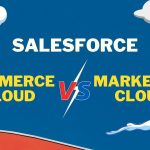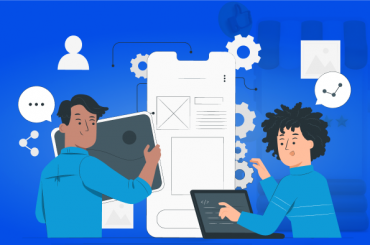Salesforce Commerce Cloud Launches Headless Digital Storefront
Last Updated | May 11, 2023
Table of Contents
Salesforce is a well-known cloud-based software company that’s popular for providing CRM services to users. Recently, they have launched a headless digital storefront that’s making waves in the eCommerce industry. Read on to know more about the latest headless digital Salesforce storefront…
Questions about scaling commerce? Read this article Salesforce eCommerce integration and What is Salesforce Commerce Cloud Pricing? The Ultimate guide to having a better understanding of the topic.
Introduction
Salesforce announced the Composable Storefront as a part of Salesforce Commerce Cloud, which is a headless digital storefront with full-range customization that allows the online retailers to make swift changes to the stores – it’s a great way of increasing the basket size, conversions, and sales while reducing the costs.
In addition, they have launched a pre-designed package for headless implementation, which includes cutting-edge integrations, implementation accelerators, and pricing. To help you understand this Salesforce storefront, we are sharing more details in this post.
Read about top Salesforce trends that will help businesses keep up with all the latest Salesforce future developments
Salesforce Commerce Cloud Launches Headless Digital Storefront
Online businesses and retailers are looking for flexible and adaptable Salesforce B2B commerce integration, WooCommerce integration, or other platforms to keep up with the changing consumer preferences and business dynamics.
Questions? Ask about Salesforce Commerce Cloud implementation, or anything else. Also, Read this Guide What Is Salesforce Commerce Cloud
For this reason, this headless Salesforce storefront has been designed that separates the backend and front-end of the eCommerce platform, which is empowering the brands to quickly customize their digital stores without impacting the consumer experience.
Some stats related to Salesforce storefront are;
- According to Salesforce, 77% of companies that have implemented a headless Salesforce storefront have identified higher agility as it allows quick changes.
- In addition, 80% of the companies that haven’t implemented the Salesforce storefront plan on implementing it in the next two years with the help of a Salesforce B2C commerce developer.
Read this article to know which one is superior: Salesforce Commerce Cloud Vs Salesforce Marketing Cloud
What Is Headless Digital Storefront?
It’s needless to say that modern consumers are looking for a secure, convenient, and engaging eCommerce experience and a headless Salesforce storefront is helping online retailers develop and implement the changes with agility and speed.
Compare the similarities and differences between Salesforce Commerce Cloud vs Demandware
The storefront is one of the most trusted and secure platforms that’s empowering retailers to leverage the headless feature while reducing costs and accelerating the marketing period. However, new businesses should hire a Salesforce or BigCommerce web design company for proper implementation.
It is designed to offer an app-like and fast experience to the consumers since there is a progressive technology that helps reduce the loading time and minimizes the disruption for consumers.
You might also want to read: Benefits of using eCommerce Site Migration
There are pre-designed integrations and accelerations that have been designed in collaboration with Constructor.io, Tryzens, 64Labs, Magnolia, contentful, Algolia, and more, to help create an engaging and composable experience with advanced search features.
These integrations will also help reduce time spent on negotiating the pricing, building personalized integrations, and sourcing the vendors. Online retailers can integrate social media features, AR, and chatbots to create an effective shopping experience – it’s apt for taking control of the brand experience.
Read this article to know which one is superior: Salesforce Commerce Cloud Vs Salesforce Marketing Cloud
With the Salesforce storefront, the new updates and features are added daily, which minimizes the deployment challenges and provides Salesforce commerce cloud development company the freedom to add new functions and iterate them, irrespective if there is peak shopping time.
It wouldn’t be wrong to say that the headless Salesforce storefront will allow businesses to transform the consumer experience by executing site changes with flexibility, precision, and agility.
Compare the similarities and differences between Salesforce Commerce Cloud vs Demandware
Currently, this new storefront by Salesforce is majorly used by healthy and beauty, media and communications, and food and beverage brands. Salesforce storefront is allowing businesses to implement headless commerce that offers freedom of expression.
You might also want to read: Salesforce Merchandising
How Will You Implement Headless Commerce Strategy?
Headless commerce strategy revolves around separating the backend and front-end functionalities of the eCommerce stores, so the retailers can build and customize the stores. In addition, it allows businesses to upgrade the front-end store without altering the backend.
Read about top Salesforce trends that will help businesses keep up with all the latest Salesforce future developments
The ultimate secret of this strategy is the API, which is a connection between the backend and front-end and sends information between these two in real-time. The consumer-based content is managed on CMS or backend platforms. In addition to CMS, PWA, CRM, and DXP can also be used.
Explore the complete Salesforce 360
The content management system, digital experience platform, progressive web apps, and customer relationship management are the SaaS tools that help create touchpoints for consumers. Whenever a consumer has a touchpoint with the store, the API sends this information to the backend.
As far as implementing the headless commerce strategy is concerned, the businesses have the option to hire a Salesforce commerce cloud consultant to build their own headless architecture or leverage the platforms that already have the such infrastructure available, such as Salesforce Composable Storefront.
Salesforce has powerful and reliable headless commerce features and integrated an array of tools to create an adaptable, customizable, and engaging storefront. It allows the brands to design engaging and efficient storefronts. In addition, there are pre-packaged integrations that extend the functionality.
You might also want to read: Salesforce Commerce Cloud Benefits
Salesforce storefront has been designed with PWA (progressive web app) to launch a mobile-friendly and fast storefront that’s customizable according to the brand. In addition, the retailers can add CX changes with minimal deployment errors
Composable Storefront: How eCommerce Businesses Can Be Scaled Up?
Composable storefront by Salesforce is one of the most flexible ways for online retailers to create an engaging consumer experience. In particular, there are the following ways how eCommerce businesses can be scaled up with Composable Storefront, such as;
-
Full-Range Customization
The headless storefront allows businesses to achieve the exact feel and aesthetics your brand needs. The brands can customize the storefronts to optimize the consumer experience and increase the conversion rate.
It separates the front-end experience from the backend, which makes it convenient to make changes to the storefront, even if you don’t have the coding and programming skills.
-
Faster Loading Time
Whenever a consumer lands in an eCommerce store, the businesses only have a few seconds to grab their attention. In particular, 64% of smartphone users want the site to load in a maximum of four seconds while online shoppers want the pages to load in two seconds or less.
Having said that, headless storefronts make it easier to design fast-loading platforms and the consumers will be able to switch between the product page and homepage at a fast speed – improving the store or website speed will positively impact the bottom line.
-
Quicker Scaling
The current websites are developed with different languages which makes it challenging to install the integrations, which negatively impacts the consumer experience. However, Salesforce headless storefront has been designed with powerful APIs that help integrate the existing systems for a positive consumer experience.
-
More Marketing Time
With the headless stores, the consumer-facing work can be completed independently without working on the backend. It means that the businesses can separate the codes and allow the teams to work on one page without waiting for the team to complete work on the other page.
You Might Want To Read These Articles:
1) Salesforce Commerce Cloud B2B Vs B2C
2) Salesforce Commerce Cloud integration
3) Salesforce Commerce Cloud for online business
4) Magento vs Salesforce Commerce Cloud
5) Salesforce B2B Commerce Cloud
6) Salesforce Commerce Cloud Implementation Guide
Final Words
Leveraging the headless infrastructure is a great way for businesses to grow, whether they are seasoned businesses with already established infrastructure or are building out the architecture. Salesforce Composable Storefront is a great opportunity for businesses to create headless storefronts.
That’s because the Salesforce storefront package is designed with pre-installed integrations and add-ons that not only extend the store’s functionality but make customization convenient and efficient as well.













